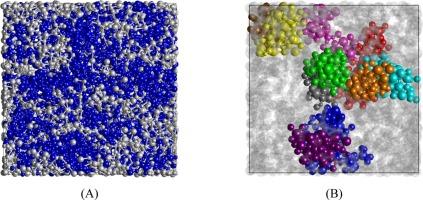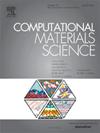聚类分析确定Mg2SiO4玻璃的结构和密度不均一性
IF 3.3
3区 材料科学
Q2 MATERIALS SCIENCE, MULTIDISCIPLINARY
引用次数: 0
摘要
在本研究中,采用先进的数据分析技术结合分子动力学模拟来研究Mg2SiO4玻璃的结构特征。分析了Mg2+的主要结构特征,包括近程有序、中程有序和环统计量,以阐明Mg2+离子的分布及其对玻璃网络的影响。DBSCAN聚类算法结合结构分析方法,揭示了富镁区微相分离。此外,结果突出了显著的结构和密度异质性。为了进一步阐明这一现象,提出了一个两相模型,并对每个相的结构特征进行了表征。研究结果揭示了高密度相和低密度相的存在,以及这些相之间的中程顺序的明显差异。此外,空穴分布分析对Mg2SiO4玻璃的结构非均质性提供了更深入的了解。先进的3D可视化技术为这种多组分氧化玻璃的原子尺度复杂性提供了深入的视角。这些结果不仅促进了对非晶态Mg2SiO4的基本认识,而且为在先进技术应用中定制材料性能提供了有价值的见解。本文章由计算机程序翻译,如有差异,请以英文原文为准。

Clustering analysis to identify structural and density heterogeneity in Mg2SiO4 glass
In this study, advanced data analysis techniques combined with molecular dynamics simulations are employed to investigate the structural characteristics of Mg2SiO4 glass. Key structural features, including short-range order, intermediate-range order, and ring statistics, are analyzed to elucidate the distribution of Mg2+ ions and their influence on the glass network. The DBSCAN clustering algorithm, integrated with structural analysis methods, reveals micro-phase separation with distinct Mg-rich regions. Additionally, the results highlight significant structural and density heterogeneities. To further clarify this phenomenon, a two-phase model is proposed, and the structural characteristics of each phase are characterized. The findings reveal the presence of both a high-density phase and a low-density phase, along with distinct differences in intermediate-range order between these phases. Furthermore, void distribution analysis provides deeper insights into the structural heterogeneity of Mg2SiO4 glass. Advanced 3D visualization techniques offer an in-depth perspective on the atomic-scale complexity of this multi-component oxide glass. These results not only advance the fundamental understanding of amorphous Mg2SiO4 but also provide valuable insights for tailoring material properties in advanced technological applications.
求助全文
通过发布文献求助,成功后即可免费获取论文全文。
去求助
来源期刊

Computational Materials Science
工程技术-材料科学:综合
CiteScore
6.50
自引率
6.10%
发文量
665
审稿时长
26 days
期刊介绍:
The goal of Computational Materials Science is to report on results that provide new or unique insights into, or significantly expand our understanding of, the properties of materials or phenomena associated with their design, synthesis, processing, characterization, and utilization. To be relevant to the journal, the results should be applied or applicable to specific material systems that are discussed within the submission.
 求助内容:
求助内容: 应助结果提醒方式:
应助结果提醒方式:


